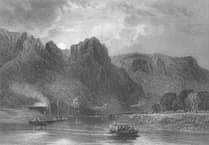St Briavels Church has become an important venue for musical performances. I remember an occasion when I was involved in a Gloucestershire Constabulary Band performance there many years ago, and now it is one of the performance venues for Wye Valley Music writes Dave Kent.
Wye Valley Music is not an orchestra or even a band, but an organisation that promotes great music and attracts great musicians, with performances up and down the Wye Valley from Chepstow to Monmouth. I remember especially a gloriously subversive ‘Moscow Drug Club’ concert or rather cabaret at Chepstow last year, which was a wonderful mixture of swing and jazz, based on seedy European night clubs of the 1930s, music apparently improvised by seedy-looking musicians.
Wye Valley Music promotes young musicians in our area, and for a provincial organisation it can attract top class performers with international reputation, including the acclaimed ‘pianist with extraordinary gifts’ (as described by the magazine ‘Gramophone’) with ‘immense power’ (The Times), who is Clare Hammond, the star soloist at St Briavels Church last Sunday. In 2016, she won the Royal Philharmonic Society’s Young Artist Award and her career since then has been outstanding. Clare performed the programme which she previously performed at the Wigmore Hall, London, earlier this month. That she was performing at our provincial venue was a great tribute to the work of Wye Valley Music and to the generosity of Clare in bringing her metropolitan programme to the Forest.
And it was the most wonderful performance by a solo performer that I can remember, with virtuoso performances of glorious and complex pieces by composers including Chopin, Mozart and Clara Schumann, and with Beethoven’s ‘Moonlight Sonata. Without needing to consult the sheet music, it was an incredible demonstration of musicality and memory. I wasn’t too sure about the piece by modern composer Jeffrey Mumford, probably because I’m an old music fan who believes that classical music stopped with Elgar (will stretch to Britten), but that is a reflection on the reviewer and the music, not its performance.
The captivated audience would not let Clare go at the end of the programme, so as an encore she provided the most breathtaking performance that I believe I have ever heard. It was a piece by South Korean composer Unsuk Chin, an impossibly complex composition of perhaps doubtful musical value, but made possible by a remarkable pianist to end a wonderful concert.
After the performance my wife and I wandered across to the George pub, which we attended quite frequently during our time in the village in the 1970s. We were delighted to hear there a different form of music, folk singers Sue Skinner and Trevor Valentine, performing home-made, Australian and Irish songs that we were tempted to join in with. A happy musical visit to St Briavels.
The Essence by Alice Sheridan
.jpeg?width=752&height=500&crop=752:500)
The High Street, Newnham on Severn, with its flourishing arts scene, must now be the cultural hub of the Forest, if not the county. There is the George, which is café with a 5 star rating, hosting local drama events and presentations, with a permanent gallery for local artists, celebrated in ‘Cotswold Life’, in one of their brief visits to this part of the county, and there is the Severnside Press, which presents exhibitions from exceptional artists through several curated exhibitions throughout the year.
And there is the Sanctuary Studio and Gallery, a dedicated art gallery. The Sanctuary is currently (until November 1) presenting ‘The Essence’, by Alice Sheridan. The Essence is a display of paintings of ethereal world of dreams, memories and seascapes. As someone with no artistic ability I always thought that art was not for me. And sadly, arts teachers at school did not believe that art had any value for people who could not draw, so they gave up on me and on similarly talentless students. At one time I worked within walking distance of the Tate Gallery, London. It didn’t occur to me to pay a visit, a decision I now bitterly regret. It was much later in life that I realised that you didn’t have to produce art to appreciate it.
.jpeg?width=752&height=500&crop=752:500)
‘The Essence’ portrays an ethereal world, on the edge of comprehension. The works are abstract, portraying seascapes where land merges into sea which merges into skies, with visions of half-forgotten images, which humans or any living creatures do not intrude upon. Colours are subdued and it’s time for introspection, memories, reflection with dreams, thoughts of infinity and always something unexpected to be discovered. We see the sea in all its moods, angry or placid and an obscure horizon, not photographic, but powerful and enigmatic.
I hope that my interpretation of Alice’s works does not appear too pretentious as I would have described it as such many years ago, before I discovered that visions, half-forgotten memories and non-realistic images are powerful artistic themes.
I’m pleased that Alice through her works and her passionate explanations of her work have proved my early views on non-realistic art wrong.





Comments
This article has no comments yet. Be the first to leave a comment.